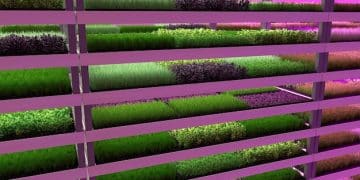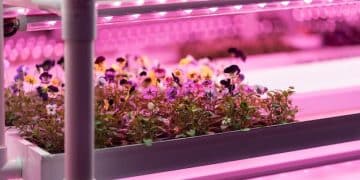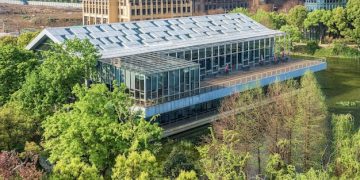Vertical Farms: Innovations Boosting US Agriculture Yields by 30%
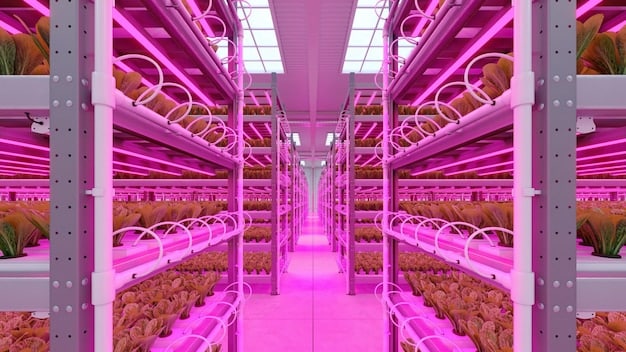
Vertical farms are revolutionizing US agriculture by leveraging innovations such as LED lighting, hydroponics, and climate control to achieve 30% higher yields compared to traditional farming methods.
Are vertical farms the future of US agriculture? Examining the 3 key innovations driving 30% higher yields, this article explores how these indoor farms are transforming food production.
What are Vertical Farms? A New Era of Agriculture
Vertical farms are more than just a trendy concept; they represent a significant shift in how we approach agriculture. These innovative facilities are designed to maximize crop yields in a controlled environment, addressing many of the limitations of traditional farming.
By growing crops indoors, often in stacked layers, vertical farms optimize space and resources. This offers a promising solution to the challenges of feeding a growing population while minimizing environmental impact. Let’s delve into the essence of vertical farming and its implications for the future of agriculture.
The Basics of Vertical Farming
Vertical farming involves growing crops in vertically stacked layers, typically indoors, using controlled-environment agriculture (CEA) technology. This method aims to optimize plant growth by controlling factors such as light, humidity, and temperature.
Advantages Over Traditional Farming
Unlike traditional farming, which is heavily reliant on weather conditions and large land areas, vertical farming offers several key advantages. It reduces water usage, eliminates the need for pesticides, and allows for year-round crop production, regardless of external climate.

Here are some advantages over traditional farming practices:
- Increased crop yields per square foot
- Reduced water consumption by up to 90%
- Elimination of pesticides and herbicides
- Year-round crop production, unaffected by weather
In essence, vertical farms represent a technological leap forward in agriculture, offering a sustainable and efficient way to produce food in urban and resource-limited environments. This shift could redefine our food systems, making them more resilient and environmentally friendly.
LED Lighting: The Powerhouse Behind Vertical Growth
One of the most critical innovations driving the success of vertical farms is the use of LED lighting. Traditional agriculture relies on sunlight, which can be inconsistent and limiting. LED lighting provides a consistent and customizable light source, essential for optimizing plant growth.
By tailoring the light spectrum to meet the specific needs of each crop, vertical farms can significantly enhance yields and nutritional content. This level of control is simply not possible with natural sunlight.
Customizing the Light Spectrum
LEDs allow farmers to fine-tune the light spectrum to match the exact requirements of different plants. For example, blue light is crucial for leafy greens, while red light promotes flowering and fruit production.
Energy Efficiency of LEDs
LEDs are significantly more energy-efficient than traditional lighting systems. This efficiency reduces the overall energy consumption of vertical farms, making them a more sustainable option.
Benefits of using LED lighting:
- Increased plant growth rates
- Reduced energy consumption
- Customizable light spectrum for different crops
- Longer lifespan compared to traditional lighting
Hydroponics and Aeroponics: Rethinking Plant Nutrition
Hydroponics and aeroponics are soilless farming techniques that have become essential in vertical farms. These methods deliver nutrients directly to the plant roots, optimizing growth and minimizing waste. This targeted approach is far more efficient than traditional soil-based farming.
By eliminating soil, hydroponics and aeroponics also reduce the risk of soilborne diseases and pests. This leads to healthier plants and higher yields. Let’s explore these innovative techniques in more detail.
Hydroponics: Growing in Water
Hydroponics involves growing plants in nutrient-rich water solutions. The roots are submerged in the water, allowing them to absorb the necessary nutrients directly.
Aeroponics: Nutrients in the Air
Aeroponics takes a slightly different approach by suspending plant roots in the air and periodically spraying them with nutrient-rich solutions. This method maximizes oxygen exposure, further enhancing plant growth.
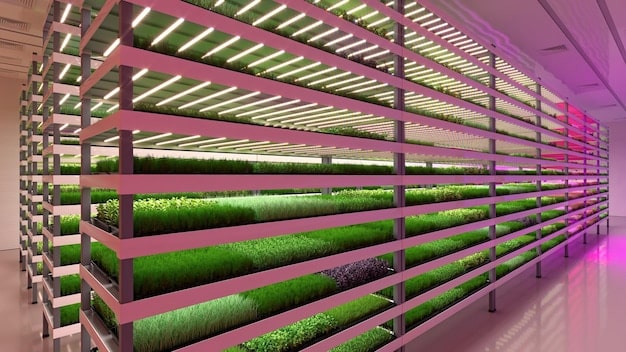
Advantages of hydroponics and Aeroponics
- Efficient nutrient delivery to plant roots
- Reduced water usage compared to soil-based farming
- Elimination of soilborne diseases and pests
- Increased plant growth rates and yields
Climate Control Systems: Creating the Perfect Growing Environment
Climate control systems are indispensable in vertical farms, ensuring that temperature, humidity, and CO2 levels are precisely managed. These systems create an ideal growing environment, regardless of external weather conditions.
By controlling these factors, vertical farms can optimize plant growth and prevent crop losses due to adverse weather. This level of environmental control is a game-changer for agricultural production.
Temperature and Humidity Control
Maintaining optimal temperature and humidity levels is crucial for plant health. Climate control systems regulate these factors, preventing stress and promoting consistent growth.
CO2 Enrichment for Enhanced Growth
CO2 enrichment involves increasing the concentration of carbon dioxide in the growing environment. This can significantly enhance photosynthesis, leading to faster growth and higher yields.
Challenges and Considerations for Vertical Farms
While vertical farms offer numerous advantages, they also present certain challenges that need to be addressed. High initial investment costs and energy consumption are significant concerns that can impact the feasibility of these operations.
However, ongoing research and technological advancements are continually addressing these challenges, making vertical farms more accessible and sustainable. Let’s explore the key challenges and potential solutions.
High Initial Investment Costs
Setting up a vertical farm requires significant capital investment in infrastructure, technology, and climate control systems. This can be a barrier to entry for many potential growers.
Energy Consumption Concerns
Vertical farms rely heavily on electricity for lighting, climate control, and other operations. This can lead to high energy consumption, especially if renewable energy sources are not utilized.
The Future of US Agriculture: Vertical Farms as a Key Player
Looking ahead, vertical farms are poised to play a significant role in the future of US agriculture. As technology continues to advance and costs decrease, these indoor farms will become more accessible and widespread.
By addressing many of the limitations of traditional farming, vertical farms offer a sustainable and efficient way to produce food in urban and resource-limited environments. This could transform our food systems, making them more resilient and environmentally friendly.
| Key Point | Brief Description |
|---|---|
| 💡 LED Lighting | Customizable spectrum for optimal plant growth. |
| 🌱 Hydroponics/Aeroponics | Soilless farming delivers nutrients directly. |
| 🌡️ Climate Control | Ideal environment, regardless of weather. |
| 💰 Investment Costs | High setup costs are a significant hurdle. |
Frequently Asked Questions
▼
Vertical farming offers increased crop yields, reduced water usage, elimination of pesticides, and year-round production, unaffected by weather conditions.
▼
LEDs allow for customized light spectrums to match different plants’ needs, increasing growth rates and reducing energy consumption compared to traditional lighting.
▼
Hydroponics grows plants in nutrient-rich water, while aeroponics suspends roots in the air, spraying them with nutrients, optimizing nutrient delivery and reducing water usage.
▼
Climate control systems regulate temperature, humidity, and CO2 levels, ensuring an ideal growing environment, regardless of external weather, and preventing crop losses.
▼
High initial investment costs and energy consumption are significant concerns, but technological advancements are continually addressing these challenges, making vertical farms more sustainable.
Conclusion
In conclusion, vertical farms represent a transformative approach to agriculture with the potential to reshape food production in the US. Innovations in LED lighting, hydroponics, and climate control are driving higher yields and greater sustainability. While challenges remain, the future looks promising as these technologies become more accessible and efficient, paving the way for vertical farms to become a key player in ensuring food security and environmental stewardship.
